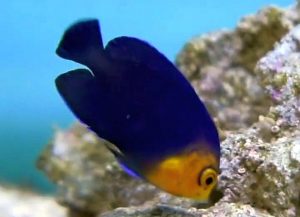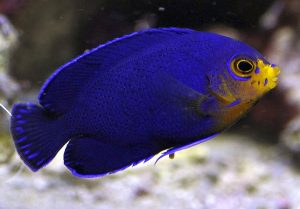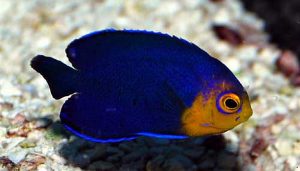The Dwarf Pygmy Angelfish (Centropyge argi) is a popular deep water species known to tropical fish keeping enthusiasts as the Cherub Angelfish, Cherubfish, Pygmy Angelfish, or Atlantic Pygmy is found in the Western Atlantic, Gulf of Mexico, the Caribbean, Florida, and the Bahamas.
The Dwarf Pygmy Angelfish has a dark royal blue body with a yellow to orange colored face and throat. The edges of their dorsal and ventral fins are edged in black and powder blue outside, and the trailing edges of the dorsal, ventral, and caudal fins have horizontal black bars.
There is no reliable way to differentiate between sexes except that males may be larger than females.
Like most dwarf angels, Dwarf Pygmy Angelfish are all born as females. As they grow the larger, the most dominant fish in a group will transform into a male. Should the male die, the next in line in the hierarchy will then turn into a male.
Keeping several juvenile specimens together is the best way to obtain a mated pair. It usually takes about two to three months for females turn and pair up. Watch for aggressiveness during this time period.
Dwarf Pygmy Angelfish are a pugnacious, omnivorous species that can be quite aggressive with others of their own kind. They are best kept separate from other angelfish when housed in an aquarium environment.
Although it’s best not to keep Dwarf Pygmy Angelfish with fish of the same genera; they can be introduced as juveniles into an aquarium of significant size with a substantial amount of live rock with enough grazing areas for each dwarf angel to stake out their own territory. Introducing multiple specimens into the tank at the same time may help with aggression levels, but they will quickly establish a pecking order. Remove individuals that get bullied or overly pestered.
Because Centropyge argi grow to only 3″ in length, they can be successfully housed in a 30 gallon tank, however, they are best kept in an aged aquarium of at least 55 gallon capacity or larger; especially if you are keeping a mated pair or a small group of this species. An “aged aquarium” should be at least 6 months old to provide the necessary algae required to feed your angelfish.
Dwarf Pygmy Angelfish do well in a typical reef setting with large amounts of live rock arranged into shelters and hiding places. The live rock should provide enough grazing area for microalgae growth that is necessary to maintain the health of the fish, but because they are constant grazers, Atlantic Pygmy angelfish will eat away at some of the reef structure and are NOT considered reef safe.
You should expect nipping on soft corals, stony coral polyps, sessile invertebrates, and clam mantles. This species loves to nibble at clams, especially the Tridacna species.
Because water quality is essential to all marine residents, regulator water changes are mandatory. In an aquarium of 30 to 55 gallon capacity, a 10% to 15% bi weekly water change is recommended. In aquariums over 100 gallons, a 20% monthly water change is considered normal maintenance. Water changes should NOT include scrubbing algae off of the interior of the tank.
Dwarf Pygmy Angelfish have been bred in captivity but raising them is extremely challenging. The aggression and fighting can be dealt with, but raising the larvae with the proper microscopic foods to feed them is the most difficult part.
Dwarf Pygmy Angelfish are protogynous hermaphrodites that practice harem breeding. A small group of juveniles raised together will form a hierarchy and the largest most dominant fish should eventually turn into a male.
Being pelagic spawners, the male and female will rise to the top of the tank where the pair release the fertilized eggs into the water column. The eggs are carried by the water column to the bottom where they hatch out into very small larvae in about 20 hours. The larvae will survive on their yolk sacs for 2 or 3 days but then need to be fed microscopic algae which may or may not be present in the tank. Tall breeding tanks are recommended for obtaining best results.
Dwarf Pygmy Angelfish are algae grazers that require feeding 2 to 3 times per day. They do best on a varied diet of spirulina, marine algae, mysis, brine, or frozen shrimp, high quality angelfish preparations, and other meaty items. This is in addition to the live rock already present in the aquarium.
Dwarf Pygmy Angelfish (Centropyge argi) are relatively common to tropical fish keeping enthusiasts and are available from fish shops, importers, online auction sites, and a variety of online retail sources at reasonable prices.
Minimum Tank Size: 30 gallons
Aquarium Type: Not Reef Compatible
Care Level: Moderate
Temperament: Semi-aggressive
Aquarium Hardiness: Hardy
Water Conditions: 72-82°F, 8 to 12 dKH , pH 8.1 – 8.4, sg 1.020-1.025
Max. Size: 3″
Color Form: Orange, Blue
Diet: Omnivore
Compatibility: Single species
Origin: Western Atlantic, Bahamas
Family: Pomacanthidae
Lifespan: 6 years
Aquarist Experience Level: Advanced





